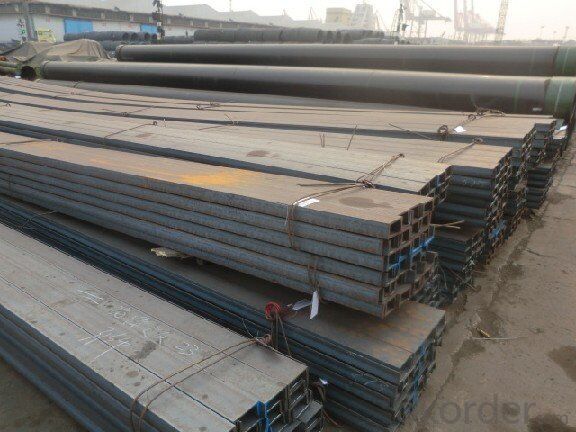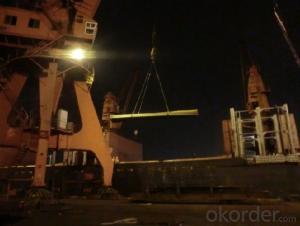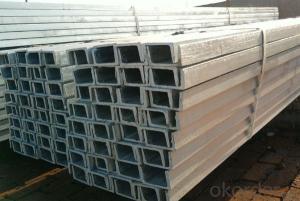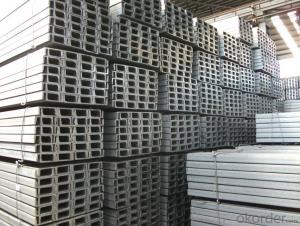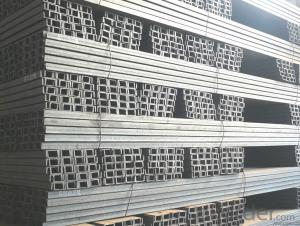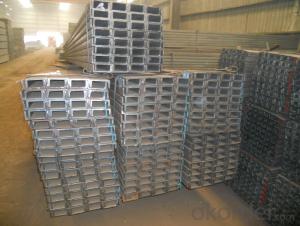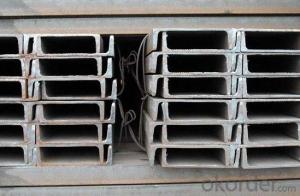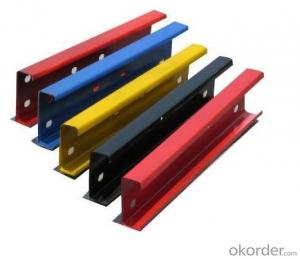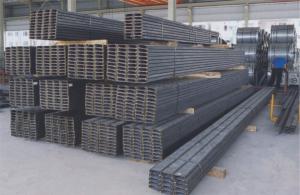Wholesale 2015 High Quality Structure Steel U Channel
- Loading Port:
- Tianjin
- Payment Terms:
- TT OR LC
- Min Order Qty:
- 25 m.t.
- Supply Capability:
- 5000 m.t./month
OKorder Service Pledge
OKorder Financial Service
You Might Also Like
Specification
high quality Hot Rolled Steel U Beam at great prices with worldwide shipping. Our supplier is a world-class manufacturer of steel, with our products utilized the world over. OKorder annually supplies products to European, North American and Asian markets. We provide quotations within 24 hours of receiving an inquiry and guarantee competitive prices.
We supply high quality MS Channel at reasonable price, including Chinese standard, Japanese standard and so on.
Standard | GB/JIS |
Material Grade | Q235,SS400 |
Technique: | Hot Rolled |
Sizes as per chinese standard: | 50*37*4.5mm - 300*89*11.5mm |
Sizes as per japanese standard: | 50*25*3mm – 200*80*7.5mm |
Length: | 6meter, 9meter, 12meter |
Product Applications:
Hot Rolled Steel U-Beams are ideal for structural applications and are widely used in the construction of buildings and bridges, and the manufacturing, petrochemical, and transportation industries.
Product Advantages:
OKorder's Steel U-Beams are durable, strong, and resist corrosion.
Main Product Features:
· Premium quality
· Prompt delivery & seaworthy packing (30 days after receiving deposit)
· Corrosion resistance
· Can be recycled and reused
· Mill test certification
· Professional Service
· Competitive pricing
Product Specifications:
Manufacture: Hot rolled
Grade: Q195 – 235
Certificates: ISO, SGS, BV, CIQ
Length: 6m – 12m, as per customer request
Packaging: Export packing, nude packing, bundled
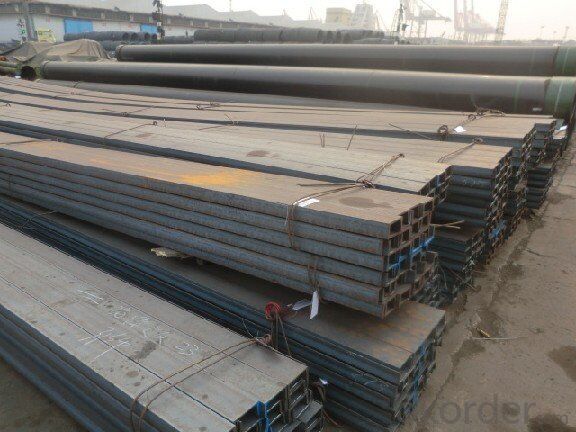
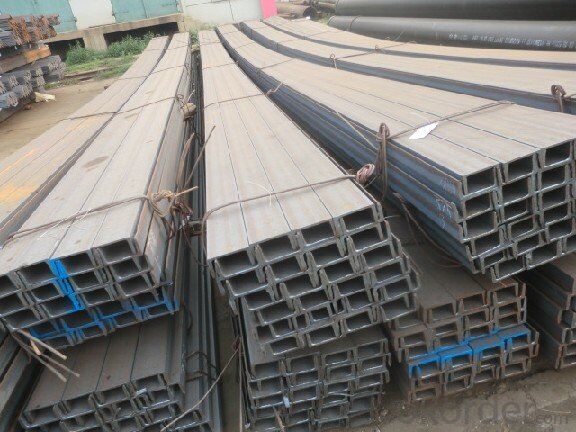
- Q: What are the different jointing methods for steel channels?
- There are several jointing methods that can be used for steel channels, depending on the specific application and requirements. Some common jointing methods for steel channels include: 1. Welding: This is one of the most commonly used jointing methods for steel channels. It involves melting the adjoining surfaces of the channels and fusing them together using heat. Welding provides a strong and permanent joint, but it requires skilled labor and proper equipment. 2. Bolting: Bolting is another popular jointing method for steel channels. It involves using bolts, nuts, and washers to secure the channels together. Bolting provides a relatively easy and flexible joint, allowing for disassembly if necessary. However, it may not be as strong as welding, particularly under dynamic or high-stress conditions. 3. Riveting: Riveting involves using rivets to join the steel channels together. Rivets are inserted through pre-drilled holes in the channels and then deformed to secure them in place. Riveting can provide a strong and durable joint, but it requires specialized equipment and skilled labor. 4. Adhesive bonding: Another jointing method for steel channels is adhesive bonding. This involves using specialized adhesives or bonding agents to join the channels together. Adhesive bonding can provide a strong and lightweight joint, but it may not be suitable for high-temperature or high-moisture environments. 5. Interlocking: Some steel channels are designed with interlocking features that allow them to be joined together without the need for additional fasteners or adhesives. This jointing method is often used in prefabricated structures or modular systems, where quick and easy assembly is desired. It is important to consider factors such as load requirements, environmental conditions, and ease of assembly when selecting the appropriate jointing method for steel channels. Consulting with structural engineers or industry professionals can help determine the most suitable jointing method for a specific application.
- Q: What are the different types of bracing for steel channels?
- There are several different types of bracing options available for steel channels, depending on the specific requirements and structural design of the project. Some of the common types of bracing for steel channels include: 1. Lateral Bracing: Lateral bracing is used to prevent the steel channels from buckling or twisting under lateral loads. This can be achieved through the use of cross-bracing, which involves diagonal members connected between the channels to provide stability. Lateral bracing can also be achieved through the use of perpendicular bracing members attached to the channels. 2. Diagonal Bracing: Diagonal bracing involves the use of diagonal members connected between the steel channels to resist the horizontal forces and provide stability. Diagonal bracing is commonly used in structures such as trusses and frames to resist wind and seismic loads. 3. Tension Bracing: Tension bracing is used to resist tensile forces in the steel channels. This can be achieved through the use of tension rods or cables connected to the channels. Tension bracing is commonly used to provide additional support and stability in structures with long spans or heavy loads. 4. Compression Bracing: Compression bracing involves the use of compression members connected to the steel channels to resist compressive forces. This type of bracing is commonly used to provide additional support and stability in structures with high vertical loads or in structures subjected to buckling. 5. Shear Bracing: Shear bracing is used to resist shear forces in the steel channels. This can be achieved through the use of shear plates or angles connected to the channels. Shear bracing is commonly used in structures subjected to lateral loads or in structures with high shear forces, such as bridges. It is important to note that the specific type of bracing used for steel channels will depend on factors such as the structural design, load requirements, and building codes/regulations. Consulting with a structural engineer or a professional with expertise in steel construction is recommended to determine the most suitable bracing option for a specific project.
- Q: What are the different methods of waterproofing steel channels?
- There are various ways to waterproof steel channels, depending on specific needs and circumstances. Some commonly used methods include: 1. Coatings: A popular approach involves applying a waterproof coating to the steel channel's surface. Epoxy, polyurethane, or rubber-based coatings can be used for this purpose. These coatings create a protective barrier that prevents water from penetrating the steel and causing corrosion. 2. Sealants: Another effective method is to use sealants to fill any gaps or joints in the steel channel. Silicone or polyurethane sealants are commonly employed for this task. These sealants form a watertight seal that prevents water from entering the channels. 3. Membranes: Waterproofing membranes can be utilized to provide a durable and long-lasting barrier against water. These membranes can be applied in various forms, such as liquid, sheet, or spray-applied versions. They adhere to the steel surface, creating a waterproof layer. 4. Grouting: Injecting grout into the gaps and voids in the steel channels can seal them and prevent water infiltration. Cementitious or epoxy-based grouts are typically used for this method. Grouting fills cracks or openings in the channels, making them waterproof. 5. Cathodic protection: In corrosive environments, cathodic protection can be employed to prevent corrosion and subsequent water infiltration. This technique involves generating an electrical current that counteracts the corrosion process and safeguards the steel from water damage. 6. Insulation: Insulating the steel channels also aids in waterproofing. Insulation helps regulate the channels' temperature, reducing the risk of condensation and water accumulation. This method proves particularly valuable in areas with significant temperature fluctuations. Consideration of specific requirements, budget, and environmental conditions is crucial when selecting the appropriate method for waterproofing steel channels. Consulting with a professional or waterproofing specialist is recommended to ensure the most suitable approach is chosen for the given application.
- Q: What does "14 channel steel" do in the template "[14"?
- Specification for dimensions and weight of hot rolled ordinary channel steel14#a height (H) 140, leg width (b) 58, waist thickness (d) 6, theoretical weight 14.535 kg14#b height (H) 140, leg width (b) 60, waist thickness (d) 8, theoretical weight 16.733 kg
- Q: How do steel channels contribute to the overall cost-effectiveness of a wastewater treatment plant?
- Steel channels contribute to the overall cost-effectiveness of a wastewater treatment plant in several ways. Firstly, steel channels are extremely durable and have a long lifespan, which means they require minimal maintenance and replacement over time. This reduces the overall operating costs of the plant as there is less need for regular repairs or replacements, resulting in lower maintenance expenses. Secondly, steel channels provide excellent structural strength and stability. They can withstand heavy loads and pressures, ensuring the integrity of the wastewater treatment system. This eliminates the need for additional reinforcements or supports, reducing construction costs and simplifying the overall design of the plant. Additionally, steel channels offer a high degree of flexibility in terms of design and installation. They can be easily customized to fit specific project requirements, allowing for efficient use of space and resources. This adaptability helps in optimizing the layout of the treatment plant, maximizing its operational efficiency, and reducing construction costs. Furthermore, steel channels are resistant to corrosion and chemical degradation, which is crucial in a wastewater treatment environment. This resistance minimizes the need for frequent replacement or repairs due to corrosion-related issues, resulting in long-term cost savings. Lastly, steel channels are often made from recycled materials, making them an environmentally friendly option. By using recycled steel, the overall cost of production is reduced, leading to lower material costs for the wastewater treatment plant. This contributes to the cost-effectiveness of the plant while also promoting sustainability and reducing the carbon footprint associated with its construction. In conclusion, steel channels contribute to the overall cost-effectiveness of a wastewater treatment plant through their durability, structural strength, flexibility, corrosion resistance, and use of recycled materials. These factors help in minimizing maintenance and replacement costs, optimizing design and construction, maximizing operational efficiency, and promoting environmental sustainability.
- Q: What are the different corrosion protection methods for steel channels in marine environments?
- Steel channels in marine environments face a high risk of corrosion due to the presence of saltwater and harsh elements. To protect against corrosion, there are several methods available: 1. Coating: Applying protective coatings, such as epoxy, polyurethane, and zinc-rich paints, creates a barrier between the steel surface and corrosive elements. This prevents direct contact and subsequent corrosion. 2. Cathodic protection: This method utilizes sacrificial anodes or impressed current to safeguard steel channels. Sacrificial anodes made of zinc or aluminum are attached to the steel channels and corrode preferentially, sacrificing themselves to protect the steel. Impressed current systems use an external power source to provide a protective electrical current. 3. Galvanization: Galvanizing steel channels involves coating them with a layer of zinc, which acts as a sacrificial layer. This sacrificial layer corrodes instead of the steel, providing protection against corrosion in marine environments. 4. Stainless steel: Utilizing stainless steel channels is another effective method. Stainless steel contains chromium, which forms a passive oxide layer on the surface, safeguarding against corrosion. It is highly resistant to corrosion in marine environments and commonly used in critical applications. 5. Proper maintenance: Regular inspection, maintenance, and upkeep are crucial to prevent corrosion in steel channels. This includes removing marine growth, repairing coating damage, and ensuring proper drainage and ventilation to minimize exposure to corrosive elements. It is important to consider factors such as the severity of the marine environment, duration of exposure, and expected lifespan of the steel channels when selecting a corrosion protection method. Consulting corrosion engineers or specialists can assist in determining the most suitable protection method for specific marine applications.
- Q: Are steel channels suitable for use in marine environments?
- Yes, steel channels are suitable for use in marine environments. Steel is known for its high strength and durability, making it resistant to corrosion and damage caused by saltwater and moisture. Additionally, steel channels can withstand the harsh conditions of marine environments, including waves, wind, and UV exposure. Proper maintenance and corrosion prevention measures are necessary to ensure long-term performance and lifespan in marine applications.
- Q: What are the guidelines for steel channel installation in corrosive environments?
- When installing steel channels in corrosive environments, there are a few guidelines that should be followed. Firstly, it is crucial to select a corrosion-resistant steel material such as stainless steel or galvanized steel. These materials have protective coatings that can withstand the corrosive elements. Additionally, proper surface preparation is essential, including cleaning the steel channels thoroughly and removing any existing corrosion or contaminants. Adequate ventilation and drainage should be provided to prevent the accumulation of moisture, which can accelerate corrosion. It is also recommended to use sealants or coatings specifically designed for corrosive environments to provide an extra layer of protection. Regular inspections and maintenance should be carried out to detect and address any signs of corrosion promptly. By adhering to these guidelines, the longevity and performance of steel channels in corrosive environments can be significantly enhanced.
- Q: Do steel channels have any specific deflection limitations?
- Steel channels do indeed have specific limits on deflection. The deflection of steel channels, along with other structural members, is influenced by factors such as their material properties, dimensions, and the loads they experience. Building codes and industry standards usually specify the maximum allowable deflection for steel channels. These limits are established based on the concept of serviceability, which ensures that the structure remains functional and safe during normal operation. The deflection restrictions for steel channels can vary depending on the particular application and loading conditions. For instance, in the design of structural steel, the deflection limits for beams and columns typically depend on the ratio of span to depth or a predetermined maximum deflection value. Engineers also take into account factors like the intended use, aesthetic considerations, and occupant comfort when determining deflection limitations. For example, in buildings where sensitive equipment or occupant comfort could be affected by vibrations or excessive deflections, stricter deflection criteria may be applied. To determine the specific deflection limitations for steel channels in a given situation, it is important to refer to relevant building codes, industry standards, and engineering guidelines. Professional structural engineers are responsible for ensuring that the design meets these requirements to guarantee the safety and performance of the structure.
- Q: How to input the sign of channel steel in Excel
- The same height of the channel, if there are several different leg width and waist thickness, also need to add a, B, C on the right side of the model to distinguish, such as 25#a, 25#b, 25#c and so on.
Send your message to us
Wholesale 2015 High Quality Structure Steel U Channel
- Loading Port:
- Tianjin
- Payment Terms:
- TT OR LC
- Min Order Qty:
- 25 m.t.
- Supply Capability:
- 5000 m.t./month
OKorder Service Pledge
OKorder Financial Service
Similar products
Hot products
Hot Searches
Related keywords



